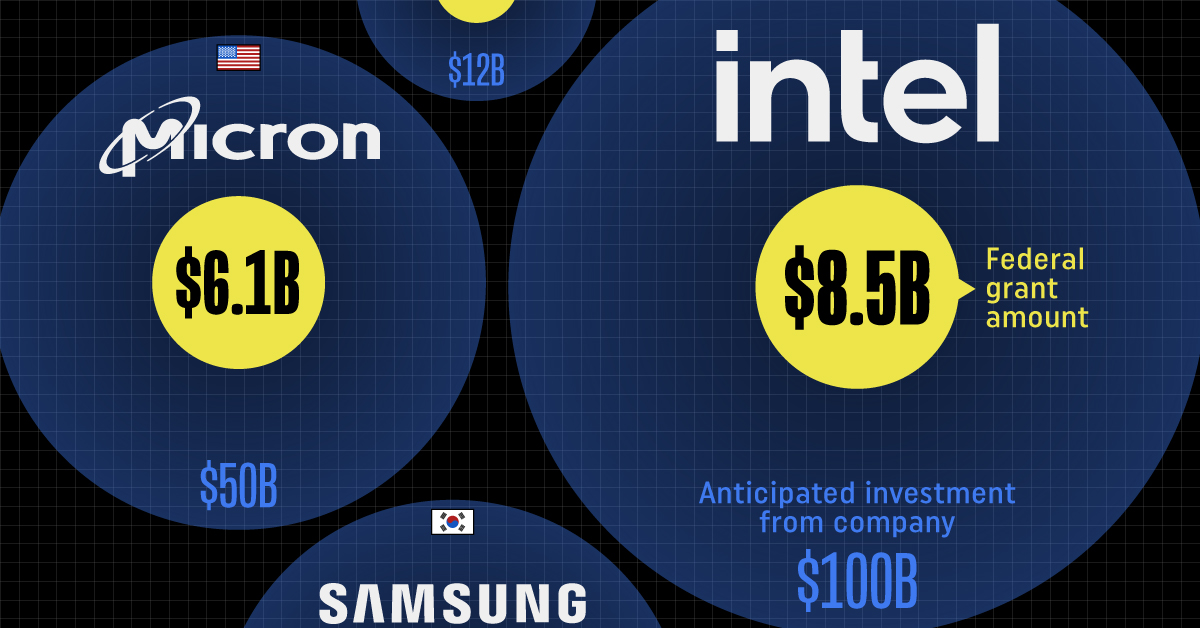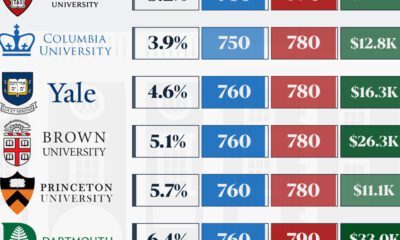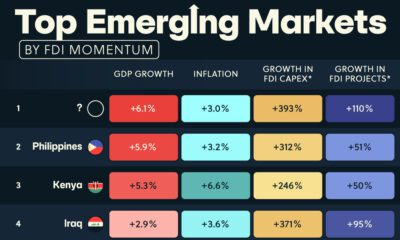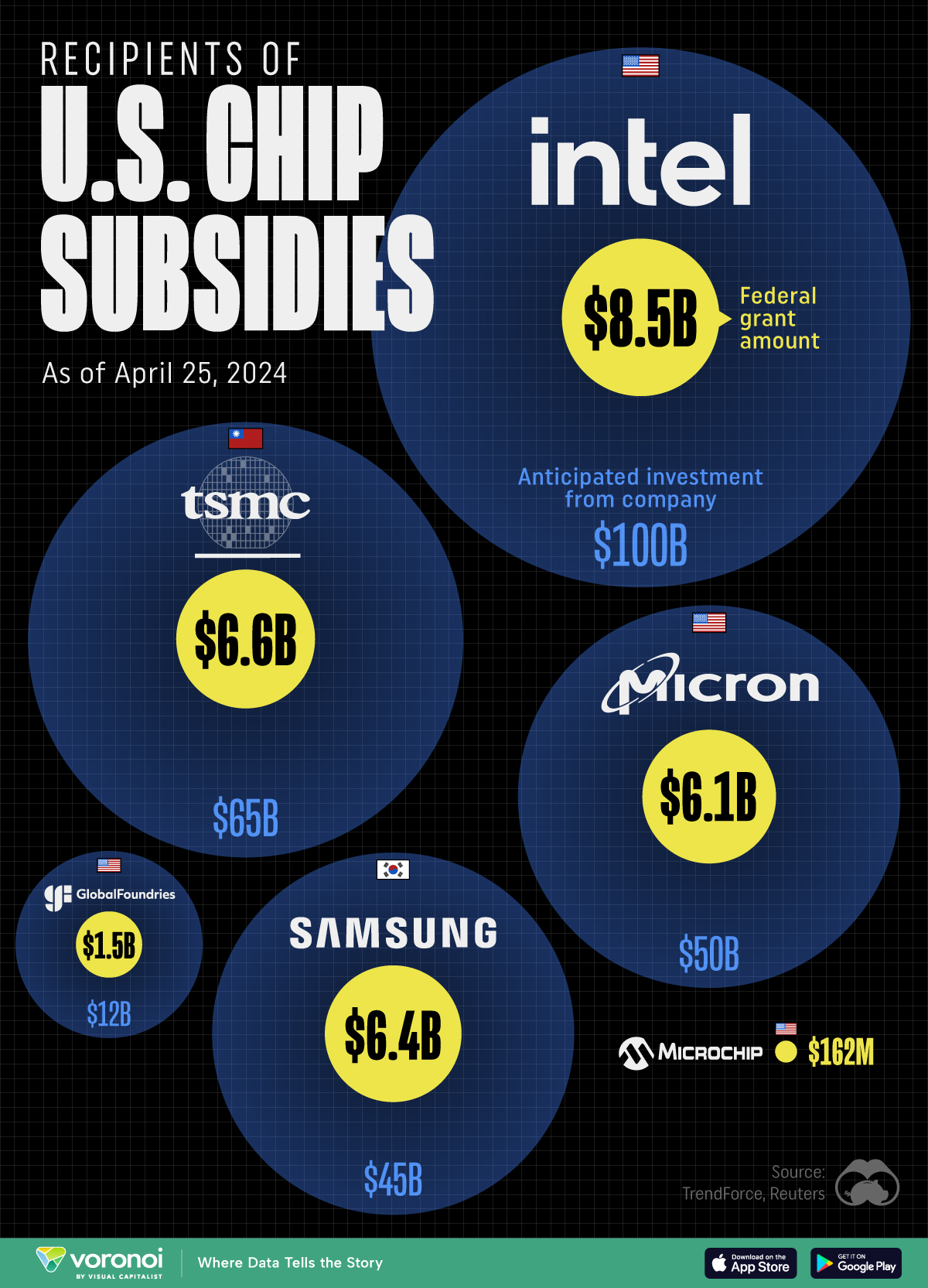Technology
Visualizing the Top Global Risks in 2024
![]() See this visualization first on the Voronoi app.
See this visualization first on the Voronoi app.
Visualizing the Top Global Risks in 2024
This was originally posted on our Voronoi app. Download the app for free on iOS or Android and discover incredible data-driven charts from a variety of trusted sources.
What is the global risk landscape in 2024?
Record global temperatures are leading to increasingly harmful impacts, a cost-of living crisis is making everyday life harder for people around the world, and escalating tensions in the Middle East have the potential to widen into a broader regional conflict.
Meanwhile, in 2024 it’s expected to be the world’s biggest election year ever with 4 billion people casting a vote across 60 countries. Will threats such as misinformation and polarization loom large as people head to the polls?
This visualization shows the biggest risks for 2024, based on the World Economic Forum’s annual survey of leaders around the globe.
Global Risk Profile in 2024
Here are the top 20 risks to the global economy, based on a survey of 1,490 leaders.
Leaders were asked to choose up to five risks that are likely to present a material crisis on a global scale in 2024:
| 2024 Ranking | Risk | Share of Respondents | Category |
|---|---|---|---|
| 1 | Extreme weather | 66% | Environmental |
| 2 | Misinformation and disinformation | 53% | Technological |
| 3 | Societal polarization | 46% | Societal |
| 4 | Cost-of-living crisis | 42% | Societal |
| 5 | Cyberattacks | 39% | Technological |
| 6 | Economic downturn | 33% | Economic |
| 7 | Disrupted supply chains for critical goods and resources | 25% | Economic |
| 8 | Escalation or outbreak of interstate armed conflict(s) | 25% | Geopolitical |
| 9 | Attacks on critical infrastructure | 19% | Geopolitical |
| 10 | Disrupted supply chains for food | 18% | Economic |
| 11 | Censorship and erosion of free speech | 16% | Societal |
| 12 | Disrupted supply chains for energy | 14% | Economic |
| 13 | Public debt distress | 14% | Economic |
| 14 | Skills or labor shortage | 13% | Economic |
| 15 | Accidental or intentional nuclear event | 12% | Geopolitical |
| 16 | Violent civil strikes and riots | 11% | Geopolitical |
| 17 | Accidental or intentional release of biological agents | 9% | Geopolitical |
| 18 | Institutional collapse within the financial sector | 7% | Economic |
| 19 | Housing bubble burst | 4% | Economic |
| 20 | Tech bubble burst | 4% | Economic |
Extreme weather poses the biggest risk according to leaders surveyed. It also ranks second overall in terms of severity over the next two years.
Global economies are widely unprepared for the consequences of acute weather, from shocks to food systems to large-scale infrastructure damage. In fact, some research shows that potentially irreversible changes to the planet could be reached by the 2030s if temperatures continue to rise.
Misinformation and disinformation is the second-biggest risk, which could diminish trust and deepen political divides. It also has the potential to undermine global elections, which are slated across the U.S., Russia, India, Mexico, and dozens of other countries.
The threat of misinformation is especially clear given advancements in AI-generated content. It ranks first overall in terms of risk severity across the list.
Interlinked with misinformation is the risk of societal polarization. In the post-pandemic era, political divides have worsened, and these have been exacerbated by economic hardship and a lack of economic opportunity.
Additionally, the conflict in the Middle East is severely impacting the livelihood of millions of people, and the recent attack in Lebanon raises questions about the outbreak of a wider war. The escalation of interstate armed conflicts ranks as the eighth-highest risk for the global economy in 2024, and the fifth-most severe.
Future Global Risks
How will global risks transform over the next decade?
By 2034, leaders surveyed believe that environmental risks will be most concerning, making up five of the top 10 risks, by severity:
| 2034 Ranking | Risk | Category |
|---|---|---|
| 1 | Extreme weather events | Environmental |
| 2 | Critical change to Earth systems | Environmental |
| 3 | Biodiversity loss and ecosystem collapse | Environmental |
| 4 | Natural resource shortages | Environmental |
| 5 | Misinformation and disinformation | Technological |
| 6 | Adverse outcomes of AI technologies | Technological |
| 7 | Involuntary migration | Societal |
| 8 | Cyber insecurity | Technological |
| 9 | Societal polarization | Societal |
| 10 | Pollution | Environmental |
We can see that technological risks of misinformation and the adverse outcomes of AI technologies also remain fairly dominant.
AI has the potential to be highly destabilizing to society, presenting some existential risks due to its role as a “force multiplier”, which means that it can increase the effect of a country’s military systems, data analytics, and other capabilities.
From a broader perspective, key structural forces are influencing global risks looking ahead. They include technological acceleration, climate change, shifts in geopolitical power, and a widening demographic divide.
Where does this data come from?
Source: The World Economic Forum’s Global Risks Report 2024.
Data note: The chart in this article is based on the Global Risks Perception Survey 2023-2024. A list of global risks and their definitions is shown in Table A.1 of the PDF. The report also includes detailed information on sample sizes and demographics of respondents, found on pg. 101.
Technology
All of the Grants Given by the U.S. CHIPS Act
Intel, TSMC, and more have received billions in subsidies from the U.S. CHIPS Act in 2024.

All of the Grants Given by the U.S. CHIPS Act
This was originally posted on our Voronoi app. Download the app for free on iOS or Android and discover incredible data-driven charts from a variety of trusted sources.
This visualization shows which companies are receiving grants from the U.S. CHIPS Act, as of April 25, 2024. The CHIPS Act is a federal statute signed into law by President Joe Biden that authorizes $280 billion in new funding to boost domestic research and manufacturing of semiconductors.
The grant amounts visualized in this graphic are intended to accelerate the production of semiconductor fabrication plants (fabs) across the United States.
Data and Company Highlights
The figures we used to create this graphic were collected from a variety of public news sources. The Semiconductor Industry Association (SIA) also maintains a tracker for CHIPS Act recipients, though at the time of writing it does not have the latest details for Micron.
| Company | Federal Grant Amount | Anticipated Investment From Company |
|---|---|---|
| 🇺🇸 Intel | $8,500,000,000 | $100,000,000,000 |
| 🇹🇼 TSMC | $6,600,000,000 | $65,000,000,000 |
| 🇰🇷 Samsung | $6,400,000,000 | $45,000,000,000 |
| 🇺🇸 Micron | $6,100,000,000 | $50,000,000,000 |
| 🇺🇸 GlobalFoundries | $1,500,000,000 | $12,000,000,000 |
| 🇺🇸 Microchip | $162,000,000 | N/A |
| 🇬🇧 BAE Systems | $35,000,000 | N/A |
BAE Systems was not included in the graphic due to size limitations
Intel’s Massive Plans
Intel is receiving the largest share of the pie, with $8.5 billion in grants (plus an additional $11 billion in government loans). This grant accounts for 22% of the CHIPS Act’s total subsidies for chip production.
From Intel’s side, the company is expected to invest $100 billion to construct new fabs in Arizona and Ohio, while modernizing and/or expanding existing fabs in Oregon and New Mexico. Intel could also claim another $25 billion in credits through the U.S. Treasury Department’s Investment Tax Credit.
TSMC Expands its U.S. Presence
TSMC, the world’s largest semiconductor foundry company, is receiving a hefty $6.6 billion to construct a new chip plant with three fabs in Arizona. The Taiwanese chipmaker is expected to invest $65 billion into the project.
The plant’s first fab will be up and running in the first half of 2025, leveraging 4 nm (nanometer) technology. According to TrendForce, the other fabs will produce chips on more advanced 3 nm and 2 nm processes.
The Latest Grant Goes to Micron
Micron, the only U.S.-based manufacturer of memory chips, is set to receive $6.1 billion in grants to support its plans of investing $50 billion through 2030. This investment will be used to construct new fabs in Idaho and New York.
-

 Misc1 week ago
Misc1 week agoHow Hard Is It to Get Into an Ivy League School?
-

 Technology2 weeks ago
Technology2 weeks agoRanked: Semiconductor Companies by Industry Revenue Share
-

 Markets2 weeks ago
Markets2 weeks agoRanked: The World’s Top Flight Routes, by Revenue
-

 Countries2 weeks ago
Countries2 weeks agoPopulation Projections: The World’s 6 Largest Countries in 2075
-

 Markets2 weeks ago
Markets2 weeks agoThe Top 10 States by Real GDP Growth in 2023
-

 Demographics2 weeks ago
Demographics2 weeks agoThe Smallest Gender Wage Gaps in OECD Countries
-

 United States2 weeks ago
United States2 weeks agoWhere U.S. Inflation Hit the Hardest in March 2024
-

 Green2 weeks ago
Green2 weeks agoTop Countries By Forest Growth Since 2001












